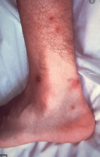USMLE questions Flashcards
(360 cards)
Describe scombroid poisoning
Scombroid poisoning is a common histamine-induced reaction that occurs within 10-30 minutes of ingesting improperly stored seafood (in temp >15C histidine in fish can undergo decarboxylation and form histamine). Symptoms include flushing, headache, palpitations, abdominal cramps, diarrhea, oral burning (“spicy”). Patients may describe a bitter taste. Exam may be notable for erythema, wheezing, tachycardia, hypotension.
Describe pufferfish poisoning
Form of food poisoning due to toxin (tetrodotoxin) and characterized by PREDOMINANT neuro symptoms: perioral tingling, incoordination weakness, etc.
Describe the management of preeclampsia with severe features
FIRST maternal stabilization: magnesium for seizure prophylaxis, short-acting antihypertensives (labetalol, hydralazine) NEXT delivery planing: preeclampsia WITHOUT severe features = delivery once >37 weeks preeclampsia WITH severe features = delivery >34 weaks
T/F: Phytoestrogens (soy, wild yams) cause nipple discharge
FALSE
Common causes of vision loss in the elderly
Among those >75yo vision loss is caused by… cortical cataracts (40%) & macular degeneration (20%) All patients should be evaluated for macular degeneration as those patients will have less (and possibly no) benefit with cataract surgery
What you should be thinking in a baby with a genital rash….
You must differentiate CONTACT dermatitis (most common) from CANDIDA dermatitis (2nd most common). Contact dermatitis spares creases/skinfolds while candida is a BEEFY red rash with satellite lesions. Contact dermatitis - treat with topical barrier ointments (zinc oxide, petrolatum) Candida dermatitis - treat with topical antifungals (nystatin)
Treatment of tertiary hyperparathyroidism
Parathyroidectomy when electrolyte derangements are persistently elevated (ca, phos, pth), soft tissue calcification or calciphylaxis, intractable bone pain or pruritus. Typically perform parathyroidectomy before renal transplant. Note that bisphosphonates actually make things worse,.
Diagnostic ECG findings of STEMI
1) New ST elevation at the J point in >/= 2 anatomically contiguous leads with the following threshold: > 1mm in all leads EXCEPT V2 and V3 (require MORE) > 1.5mm in women, >2mm in men >40yo and >2.5 in men <40 in leads V2 and V3 2) New LBB with clinical presentation of ACS https://emergencymedicinecases.com/wp-content/uploads/2019/08/Screen-Shot-2019-08-13-at-2.53.25-PM.png https://www.google.com/imgres?imgurl=https%3A%2F%2Flitfl.com%2Fwp-content%2Fuploads%2F2018%2F08%2FECG-LBBB-AF.jpg&imgrefurl=https%3A%2F%2Flitfl.com%2Fleft-bundle-branch-block-lbbb-ecg-library%2F&tbnid=Hh3kvU30NveAoM&vet=12ahUKEwiJqpr__dbpAhWtADQIHcdOCXIQMygAegUIARCOAg..i&docid=74EpJHi54BFfDM&w=1200&h=627&q=lbbb&hl=en-us&client=safari&ved=2ahUKEwiJqpr__dbpAhWtADQIHcdOCXIQMygAegUIARCOAg
EKG finding suggestive of pericarditis
Diffuse 1mm ST elevations with PR depression
Describe RBBB EKG findings
R prime (second R wave) in V1 accompanied by widened S wave in V6
EKG findings suggestive of right heart strain
T wave inversions in leads II, III, and aVF
Describe different etiologies of sinus bradycardia after MI
Sinus bradycardia in INFERIOR wall MI are typically transient and RESPONSIVE to atropine (bc they are due to increase in vagal tone) Sinus bradycardia in ANTERIOR wall MI are due to damage to conduction system BELOW the AV node and AV nodal block is typically NOT responsive to atropine and requires transcutaneous cardiac pacing
Describe the diagnostic algorithm when suspect pheochromocytoma
1 - 24hr urine fractioned metanephrines and catecholamines, plasma fractionated metanephrines > If negative, repeat during spell
2 - CT scan or MRI of abdomen
> Negative - consider further imaging, i.e. MIBG scan, octreotide scan, PET, whole-body MRI
> Positive - surgical eval, genetic testing, MIBG scan if very large (>5cm) tumor (may have extraadrenal disease, mets), alpha and beta blockade prior to surgery
Appropriate use of CENTOR criteria
If a patient has 3 or more of criteria then TEST with rapid strep test (culture takes too long) If <3 criteria then do not need to test Cough (absent) Exudates Nodes (anterior) Temperature OR (younger OR older; <14 +1, >45 -1)
W/u of UTI in babies
All children <24mo with SINGLE febrile UTI should undergo renal and bladder ultrasound to evaluate for hydronephrosis and uretal dilation suggestive of anatomic abnormality If abnormal US or recurrent febrile UTIs THEN undergo voiding cystourethrogram
Diagnosis and treatment of psoriasis
Diagnosis of psoriasis is CLINICAL (bx not necessary) If isolated plaque psoriasis then topical glucocorticoids or vitamin D derivatives (calcipotrient) may be sufficient If joint involvement then SYSTEMIC treatment with methotrexate (not oral steroids - may trigger pustular psoriasis)
Detrimental effects of estorgen/progesterone menopausal hormonal therapy
VTE Breast cancer CAD Stroke Gallbladder disease (mostly in women >60yo)
When to consider stress or pharmacological echo?
Patients with low risk non ST elevation MI or unstable angina based on TIMI score
How do glucocorticoids cause osteoporosis?
They decrease absorption of calcium from the gut, cause renal calcium wasting, and have a direct anti-anabolic effect on the bone. They also suppress the release of GrH from the hypothalamus leading to central hypogonadism
Causes of urinary incontinence in the elderly
A. Genitourinary - > decreased detrusor contractility, detrusor overactivity > Bladder or urethral obstruction (tumor, BPH) > Urethral sphincter or pelvic floor weakness > Urogenital fistula B. Neurological - > MS > Dementia - Parkinson’s, Alzheimer’s, NPH > Spinal cord injury, disk hernia Timon C. Potentially REVERSIBLE - DIAPPERS > Delirium > Infection > Atrophic urethritis/vaginitis > Pharmaceuticals - I.e. alpha blockers, anti holiness is, opiates, CCB (urinary retention/overflow), diuretics > Psychological - I.e. depression > Excessive urine output (I.e. diabetes, CHF) > Restricted mobility (I.e. post surgery) > Stool impaction
When should women be given intrapartum prophylaxis for GBS
GBS bacteriuria or GBS UTI in CURRENT pregnancy (regardless of treatment) GBS-positive rectovaginal culture in current pregnancy Unknown GBS status PLUS any of the following: > LESS than 37 weeks gestation > Intrapartum fever > ROM for > 18hrs Prior infant with early-onset neonatal GBS infection
Describe lab and pathology features of celiac disease
Lab features: > Increased stool osmotic gap > Microcytic anemia, iron deficiency Pathology: villous atrophy!
Treatment of antifreeze (ethylene glyco) ingestion
Fomepizole (better than ethanol) with immediate dialysis
What cause of glomerulonephritis has high association with neuropathy?
Polyarthritis nodosa (PAN) - involvement of every organ EXCEPT the lung Associated with multiple motor and sensory neuropathy with pain




































